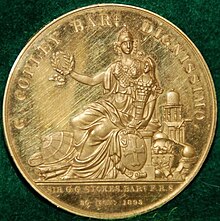
Collection this Document is Affiliated with:
Description: Benjamin Franklin was awarded the Copley Medal in 1753 for his work on electricity involving identifying the existence of conductors and insulators, as well as proving that lightning is electricity. His famous kite flight during a thunderstorm led to the invention of the lightning rod, which remains mostly unchanged on mainly tall buildings today. His scientific genius was recognized by the Royal Society, the oldest scientific academy in continuous existence.
Categories of Documents:
The award
The Copley Medal is The Royal Society’s oldest and most prestigious award. The medal is awarded for sustained, outstanding achievements in any field of science.
First awarded in 1731 following donations from Godfrey Copley FRS (PDF), it was initially awarded for the most important scientific discovery or for the greatest contribution made by experiment. The Copley Medal is thought to be the world's oldest scientific prize and it was awarded 170 years before the first Nobel Prize. Notable winners include Benjamin Franklin, Dorothy Hodgkin, Albert Einstein and Charles Darwin. The medal is of silver gilt, is awarded annually, alternating between the physical and biological sciences (odd and even years respectively), and is accompanied by a a gift of £25,000.
Citation: “Copley Medal: Royal Society.” The Royal Society, royalsociety.org/medals-and-prizes/copley-medal/. Accessed 4 Mar. 2025.

